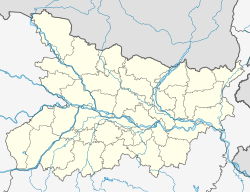Sack of Champaranya
| Sack of Champaranya | |||||||||
|---|---|---|---|---|---|---|---|---|---|
| Part of Kalachuri Expansion | |||||||||
 Amarkantak Temple. | |||||||||
| |||||||||
| Belligerents | |||||||||
| Kalachuris of Tripuri | Palas of Bengal | ||||||||
| Commanders and leaders | |||||||||
|
Yashahkarna Purusha-shiva |
Shurapala II Ramapala | ||||||||
| Casualties and losses | |||||||||
| Negligable | Heavy to severe | ||||||||
Location within Bihar | |||||||||
The Sack of Champaranya was the looting of the region of Champaran by Kalachuri king Yashahkarna. It was a victory for the Kalachuris, who defeated the Palas under Shurapala II and managed to avoid a severe counteroffensive during the looting.[1][2]
Background
[edit]The Pala Empire was undergoing an extremely unstable period during the reigns of rulers Vigrahapala III, Mahipala II and Shurapala II. During this period, the Varendra rebellion had destabilized the realm and by then Mahipala II had suffered his demise at the hands of the rebellion.[3] Additionally, they had been weakened by Vikramaditya VI's Northern expedition.[4][5][6]
Sacking
[edit]Seeing the oppurtunity, the Kalachuri king Yashahkarna advanced into Pala lands, targeting the land of Champaran, and defeating the Pala forces there. Then, he devastated the region, gaining high amounts of loot.[2][1]
Aftermath
[edit]This event only further destabilized the Pala realm, which approached collapse, but was rescued by Shurapala II's younger brother, Ramapala. He would go on to become the last powerful Pala ruler, although his son Kumarapala managed to maintain most of his territories.
See also
[edit]References
[edit]- ^ a b Mirashi, Vasudev Vishnu (1955). Inscriptions of the Kalachuri-Chedi Era. Corpus Inscriptionum Indicarum. Vol. 4, Part 1. Ootacamund: Government Epigraphist for India. p. 494.
- ^ a b Sircar, D. C. (1952). "Bangaon Plate of Vigrahapala III; Regnal Year 17". Epigraphia Indica. 29: 48–57. Retrieved 13 December 2024.
- ^ "History of Bengal Vol.1".
- ^ B.P. Sinha in George E. Somers (1977), p.214
- ^ Sen (1999), p.282
- ^ Majumdar, R. C. (1952), p.320

